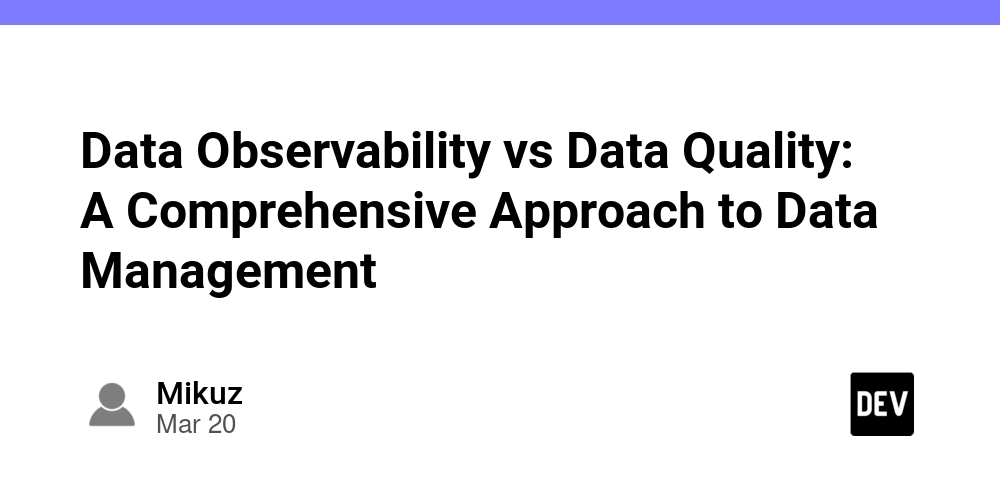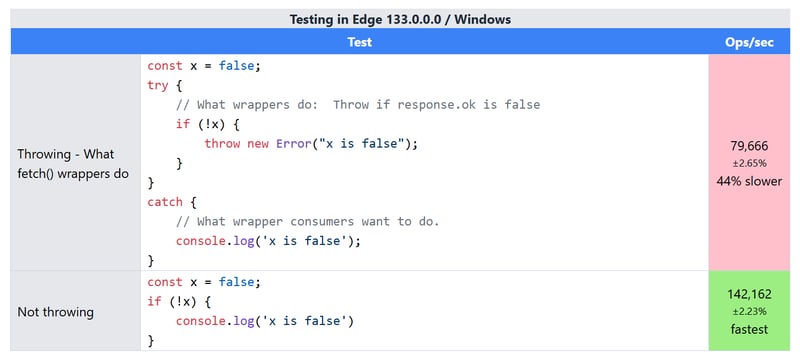Data Observability vs Data Quality: A Comprehensive Approach to Data Management
In today's data-driven enterprise environment, understanding the relationship between data observability vs data quality has become crucial for maintaining robust data systems. While these two disciplines are distinct, they work together to create a comprehensive approach to data management. Data quality focuses on ensuring information accuracy and reliability through structured validation processes, while data observability monitors the health and performance of data pipelines in real-time. Organizations that implement both practices effectively can significantly improve their data operations, reduce system failures, and build stronger trust in their data infrastructure. This symbiotic relationship between quality control and system monitoring helps businesses make more informed decisions while maintaining the integrity of their data ecosystem. Understanding Data Quality Data quality represents the foundation of reliable business intelligence and decision-making. It encompasses multiple dimensions that collectively determine whether data meets organizational standards and business requirements. Essential Dimensions of Data Quality Six fundamental dimensions define high-quality data in enterprise systems: Accuracy: Data values must precisely match real-world conditions. For instance, customer shipping addresses must reflect current, valid locations. Completeness: Datasets should contain all required fields without gaps. A product catalog entry needs every specified attribute filled, from pricing to specifications. Consistency: Information must remain uniform across all platforms and databases. Employee records should display identical information whether accessed through HR systems or payroll software. Timeliness: Data must be current and accessible when needed. Financial transactions should reflect immediately across all relevant systems. Validity: Information must adhere to predetermined formats and rules. Email addresses must contain proper syntax and domain structures. Uniqueness: Records should exist without duplication. Each customer should have one master record in the database. Strategic Implementation of Data Quality Organizations implement several key strategies to maintain high data quality: Statistical Profiling: Automated analysis tools examine data patterns and flag anomalies or inconsistencies. Cleansing Protocols: Systematic processes remove errors, standardize formats, and eliminate redundant entries. Validation Systems: Automated checks ensure new data meets established quality standards before entering production systems. Enhancement Procedures: Methods to augment existing data with additional context or missing information. Governance Framework: Comprehensive policies that guide data handling, quality control, and maintenance procedures. Poor data quality can severely impact business operations, leading to flawed analytics, misguided strategic decisions, and inefficient resource allocation. In modern enterprises, maintaining high data quality transcends technical requirements - it becomes a critical business imperative that directly affects operational efficiency and competitive advantage. Data Observability: Monitoring Pipeline Health Data observability functions as an early warning system for data infrastructure, enabling organizations to detect and resolve issues before they impact business operations. This proactive approach to data pipeline monitoring relies on automated systems that continuously track performance metrics and data flow. Core Pillars of Data Observability Data Freshness: Monitors update frequencies and identifies delays in data delivery. Trading platforms require real-time price updates, making freshness monitoring critical for market operations. Pattern Distribution: Analyzes data patterns to detect unusual behavior. Banking systems use distribution monitoring to identify suspicious transaction patterns that might indicate security breaches. Volume Tracking: Measures data throughput across systems. E-commerce platforms monitor order volume to ensure processing systems handle peak shopping periods efficiently. Schema Management: Tracks structural changes in data organization. Database administrators receive alerts when table structures change unexpectedly, preventing downstream processing errors. Data Lineage: Maps data movement and transformation across systems. Analytics teams can trace reporting discrepancies to specific pipeline stages for quick resolution. Implementation Strategies Organizations deploy several key techniques to enhance data observability: Unified Logging Systems: Consolidate system logs into a central platform for comprehensive pipeline visibility and rapid troubleshooting. Continuous Monitoring: Deploy automated tools that track key performance indicators and system health metrics in real-time. Alert Management: Implement intelligent alerting s

In today's data-driven enterprise environment, understanding the relationship between data observability vs data quality has become crucial for maintaining robust data systems. While these two disciplines are distinct, they work together to create a comprehensive approach to data management. Data quality focuses on ensuring information accuracy and reliability through structured validation processes, while data observability monitors the health and performance of data pipelines in real-time. Organizations that implement both practices effectively can significantly improve their data operations, reduce system failures, and build stronger trust in their data infrastructure. This symbiotic relationship between quality control and system monitoring helps businesses make more informed decisions while maintaining the integrity of their data ecosystem.
Understanding Data Quality
Data quality represents the foundation of reliable business intelligence and decision-making. It encompasses multiple dimensions that collectively determine whether data meets organizational standards and business requirements.
Essential Dimensions of Data Quality
Six fundamental dimensions define high-quality data in enterprise systems:
- Accuracy: Data values must precisely match real-world conditions. For instance, customer shipping addresses must reflect current, valid locations.
- Completeness: Datasets should contain all required fields without gaps. A product catalog entry needs every specified attribute filled, from pricing to specifications.
- Consistency: Information must remain uniform across all platforms and databases. Employee records should display identical information whether accessed through HR systems or payroll software.
- Timeliness: Data must be current and accessible when needed. Financial transactions should reflect immediately across all relevant systems.
- Validity: Information must adhere to predetermined formats and rules. Email addresses must contain proper syntax and domain structures.
- Uniqueness: Records should exist without duplication. Each customer should have one master record in the database.
Strategic Implementation of Data Quality
Organizations implement several key strategies to maintain high data quality:
- Statistical Profiling: Automated analysis tools examine data patterns and flag anomalies or inconsistencies.
- Cleansing Protocols: Systematic processes remove errors, standardize formats, and eliminate redundant entries.
- Validation Systems: Automated checks ensure new data meets established quality standards before entering production systems.
- Enhancement Procedures: Methods to augment existing data with additional context or missing information.
- Governance Framework: Comprehensive policies that guide data handling, quality control, and maintenance procedures.
Poor data quality can severely impact business operations, leading to flawed analytics, misguided strategic decisions, and inefficient resource allocation. In modern enterprises, maintaining high data quality transcends technical requirements - it becomes a critical business imperative that directly affects operational efficiency and competitive advantage.
Data Observability: Monitoring Pipeline Health
Data observability functions as an early warning system for data infrastructure, enabling organizations to detect and resolve issues before they impact business operations. This proactive approach to data pipeline monitoring relies on automated systems that continuously track performance metrics and data flow.
Core Pillars of Data Observability
- Data Freshness: Monitors update frequencies and identifies delays in data delivery. Trading platforms require real-time price updates, making freshness monitoring critical for market operations.
- Pattern Distribution: Analyzes data patterns to detect unusual behavior. Banking systems use distribution monitoring to identify suspicious transaction patterns that might indicate security breaches.
- Volume Tracking: Measures data throughput across systems. E-commerce platforms monitor order volume to ensure processing systems handle peak shopping periods efficiently.
- Schema Management: Tracks structural changes in data organization. Database administrators receive alerts when table structures change unexpectedly, preventing downstream processing errors.
- Data Lineage: Maps data movement and transformation across systems. Analytics teams can trace reporting discrepancies to specific pipeline stages for quick resolution.
Implementation Strategies
Organizations deploy several key techniques to enhance data observability:
- Unified Logging Systems: Consolidate system logs into a central platform for comprehensive pipeline visibility and rapid troubleshooting.
- Continuous Monitoring: Deploy automated tools that track key performance indicators and system health metrics in real-time.
- Alert Management: Implement intelligent alerting systems that notify teams of potential issues based on predefined thresholds.
- Dependency Mapping: Create detailed maps of data relationships and system dependencies to understand impact patterns.
- Issue Resolution Protocol: Establish systematic approaches to investigate and resolve data pipeline incidents.
Modern data infrastructure requires robust observability practices to maintain reliability and performance. By implementing comprehensive monitoring systems, organizations can quickly identify bottlenecks, prevent data quality issues, and ensure smooth operation of their data pipelines. This proactive approach reduces system downtime, improves data reliability, and supports better decision-making across the organization.
Combining Data Quality and Observability for Maximum Impact
The integration of data quality measures and observability practices creates a comprehensive framework for managing modern data infrastructure. When implemented together, these disciplines strengthen an organization's ability to deliver reliable, actionable data while maintaining system performance.
Synergistic Benefits
- Enhanced Problem Detection: Quality checks combined with pipeline monitoring enable faster identification of data issues at both content and system levels.
- Improved Root Cause Analysis: Integrated monitoring helps teams quickly determine whether problems stem from data quality issues or system performance concerns.
- Streamlined Operations: Unified approaches to quality and observability reduce redundant monitoring efforts and create more efficient workflows.
- Comprehensive Data Trust: Organizations build confidence in their data assets through multiple layers of validation and monitoring.
Implementation Framework
| Aspect | Quality Focus | Observability Focus |
|---|---|---|
| Monitoring | Content validation and accuracy checks | System performance and pipeline health |
| Alerts | Data standard violations | Pipeline processing issues |
| Stakeholders | Data analysts and business users | Engineering and operations teams |
Strategic Integration Points
Organizations should focus on several key areas when combining quality and observability practices:
- Unified Dashboards: Create consolidated views that display both quality metrics and system health indicators.
- Automated Response Systems: Develop workflows that address both data quality issues and pipeline performance problems.
- Cross-functional Teams: Build teams that understand both quality requirements and system operations.
- Integrated Tools: Select and implement tools that support both quality management and observability functions.
The successful integration of data quality and observability practices enables organizations to address both known data management challenges and unexpected issues that may arise. This comprehensive approach ensures data reliability while maintaining system performance, creating a robust foundation for data-driven decision making.
Conclusion
Organizations must recognize that data quality and observability represent two essential pillars of modern data management. While data quality ensures information accuracy and reliability through systematic validation and standardization, data observability provides crucial insights into system performance and pipeline health. Together, they create a robust framework that supports data-driven decision making and operational excellence.
Success in today's data-intensive business environment requires a balanced approach that incorporates both disciplines. Organizations that implement comprehensive data quality measures alongside sophisticated observability tools position themselves to:
- Detect and resolve data issues before they impact business operations
- Maintain consistent data pipeline performance across complex systems
- Build greater trust in data assets throughout the organization
- Reduce operational costs through proactive issue management
- Support more effective data-driven decision making
As data systems continue to grow in complexity and business reliance on data increases, the relationship between quality and observability becomes increasingly critical. Organizations that invest in both areas while ensuring their integration will be better equipped to handle future data challenges and maintain competitive advantage in their respective markets.













































































































































































![[The AI Show Episode 142]: ChatGPT’s New Image Generator, Studio Ghibli Craze and Backlash, Gemini 2.5, OpenAI Academy, 4o Updates, Vibe Marketing & xAI Acquires X](https://www.marketingaiinstitute.com/hubfs/ep%20142%20cover.png)



























































































































![[FREE EBOOKS] The Kubernetes Bible, The Ultimate Linux Shell Scripting Guide & Four More Best Selling Titles](https://www.javacodegeeks.com/wp-content/uploads/2012/12/jcg-logo.jpg)



![From drop-out to software architect with Jason Lengstorf [Podcast #167]](https://cdn.hashnode.com/res/hashnode/image/upload/v1743796461357/f3d19cd7-e6f5-4d7c-8bfc-eb974bc8da68.png?#)





































































































.png?#)





.jpg?#)
































_Christophe_Coat_Alamy.jpg?#)










































































































![Rapidus in Talks With Apple as It Accelerates Toward 2nm Chip Production [Report]](https://www.iclarified.com/images/news/96937/96937/96937-640.jpg)





































































































































